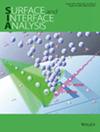Investigating the structure of the oxide on Ni‐Cr‐Mo alloys while presenting a method for analysis of complex oxides using QUASES
IF 1.8
4区 化学
Q4 CHEMISTRY, PHYSICAL
引用次数: 1
Abstract
X‐ray photoelectron spectroscopy (XPS) is a technique that is widely used to study thin oxide films because of its extremely high surface sensitivity. Utilizing the QUASES (Quantitative Analysis of Surfaces by Electron Spectroscopy) software package developed by Sven Tougaard (University of Southern Denmark), a user can obtain additional information that is not extracted in conventional XPS analysis, specifically the composition as a function of depth. Presented here is the QUASES analysis of four Ni‐Cr‐Mo alloys performed while testing various inelastic mean free path (IMFP) determination methods in the context of providing a framework for the analysis of complex oxides in QUASES. Ni‐Cr‐Mo alloys are often used to replace conventional materials under aggressive conditions, because of their exceptional corrosion resistance. Their corrosion resistance is conferred by the formation of an inert surface oxide film that protects the underlying metal. Using the QUASES software, the thickness of the air‐formed oxide on four Ni‐Cr‐Mo alloys was found to lie within the range of 2.5–3.6 nm. They were found to be composed of an inner Cr2O3 layer and an outer Cr (OH)3 layer, with a transition zone where the two coexisted. Oxidized Mo species, MoO2 and MoO3, were found in trace amounts at the boundary between the Cr2O3‐only and mixed Cr2O3/Cr (OH)3 regions of the oxide. We also determined that using 20% reduced IMFP values gave results similar to those obtained using electron effective attenuation length (EAL) values. Auger depth profiles showed comparable trends to the QUASES models.研究了Ni - Cr - Mo合金上氧化物的结构,同时提出了一种用QUASES分析复合氧化物的方法
X射线光电子能谱(XPS)是一种广泛用于研究氧化物薄膜的技术,因为它具有极高的表面灵敏度。利用Sven Tougaard(南丹麦大学)开发的QUASES(电子光谱表面定量分析)软件包,用户可以获得传统XPS分析中未提取的附加信息,特别是作为深度函数的成分。本文介绍了在测试各种非弹性平均自由程(IMFP)测定方法时对四种Ni-Cr-Mo合金进行的QUASES分析,为QUASES中复杂氧化物的分析提供了框架。Ni‐Cr‐Mo合金由于其优异的耐腐蚀性,通常用于在侵蚀性条件下取代传统材料。它们的耐腐蚀性是由保护底层金属的惰性表面氧化膜形成的。使用QUASES软件,发现四种Ni-Cr-Mo合金上的空气形成氧化物的厚度在2.5–3.6 nm范围内。发现它们由内部Cr2O3层和外部Cr(OH)3层组成,具有两者共存的过渡区。在氧化物的仅Cr2O3和混合Cr2O3/Cr(OH)3区域之间的边界处发现了微量的氧化Mo物种MoO2和MoO3。我们还确定,使用减少20%的IMFP值得到的结果与使用电子有效衰减长度(EAL)值获得的结果相似。俄歇深度剖面显示出与QUASES模型相当的趋势。
本文章由计算机程序翻译,如有差异,请以英文原文为准。
求助全文
约1分钟内获得全文
求助全文
来源期刊

Surface and Interface Analysis
化学-物理化学
CiteScore
3.30
自引率
5.90%
发文量
130
审稿时长
4.4 months
期刊介绍:
Surface and Interface Analysis is devoted to the publication of papers dealing with the development and application of techniques for the characterization of surfaces, interfaces and thin films. Papers dealing with standardization and quantification are particularly welcome, and also those which deal with the application of these techniques to industrial problems. Papers dealing with the purely theoretical aspects of the technique will also be considered. Review articles will be published; prior consultation with one of the Editors is advised in these cases. Papers must clearly be of scientific value in the field and will be submitted to two independent referees. Contributions must be in English and must not have been published elsewhere, and authors must agree not to communicate the same material for publication to any other journal. Authors are invited to submit their papers for publication to John Watts (UK only), Jose Sanz (Rest of Europe), John T. Grant (all non-European countries, except Japan) or R. Shimizu (Japan only).
 求助内容:
求助内容: 应助结果提醒方式:
应助结果提醒方式:


